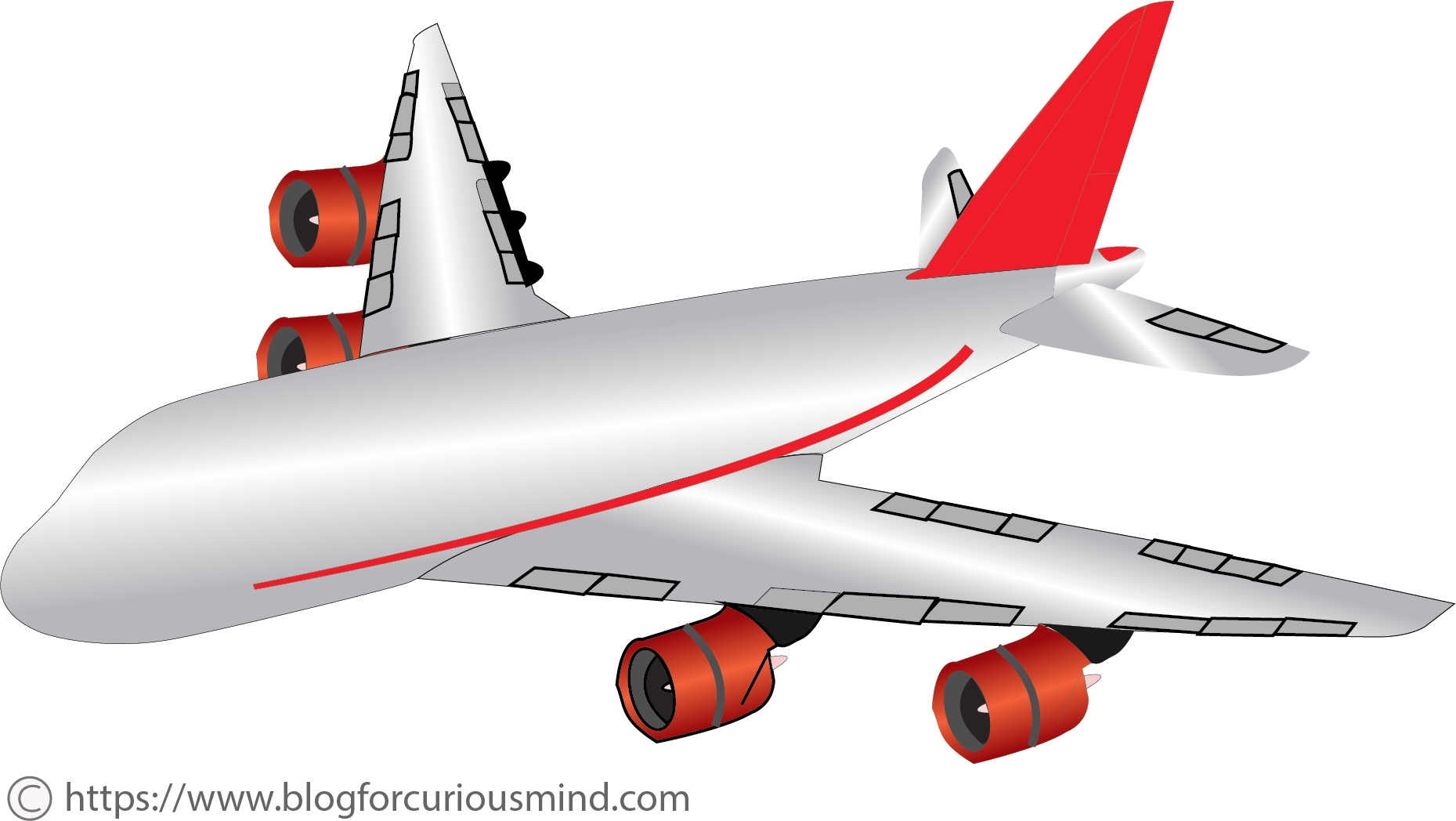Introduction
The sight of an airplane in the sky or taking off or landing at an airport makes us wonder about the technology involved in it. It is simply marvelous.
Don’t you wonder how such a huge metal bird effortlessly takes off, flies to the destination, and lands safely?
How an airplane flies. How many controls does it have? And, what is its weight? Keep reading to learn more about the fascinating world of airplanes.
This article takes you through the subtopics of
- How an airplane fly
- Forces experienced by an airplane
- Major parts of an airplane
- How airplane wings lift the airplane
- Three axes of airplane flight- pitch, roll, and yaw
- What is the speed of an airplane
- And what is the weight of an airplane?
Forces experienced by an airplane
When an airplane is in the air doing a level flight, it undergoes four forces. They are lift, gravity, thrust, and drag. ‘Lift and gravity‘, and ‘thrust and drag‘ are the forces opposing each other.
The thrust is created by the jet engine or propeller of the airplane. This is the force that moves it forward.
Drag is the air resistance experienced by the airplane when it moves forward and it tries to slow down the airplane’s forward movement.
Gravity is the earth’s gravitational pull/force that pulls all objects down towards the earth.
Lift is the upward force created by the air moving above and below the aircraft wings. The cross-section of the wings is designed in such a way that this movement of air creates a difference in pressure resulting in a lift force that is higher than the gravity.
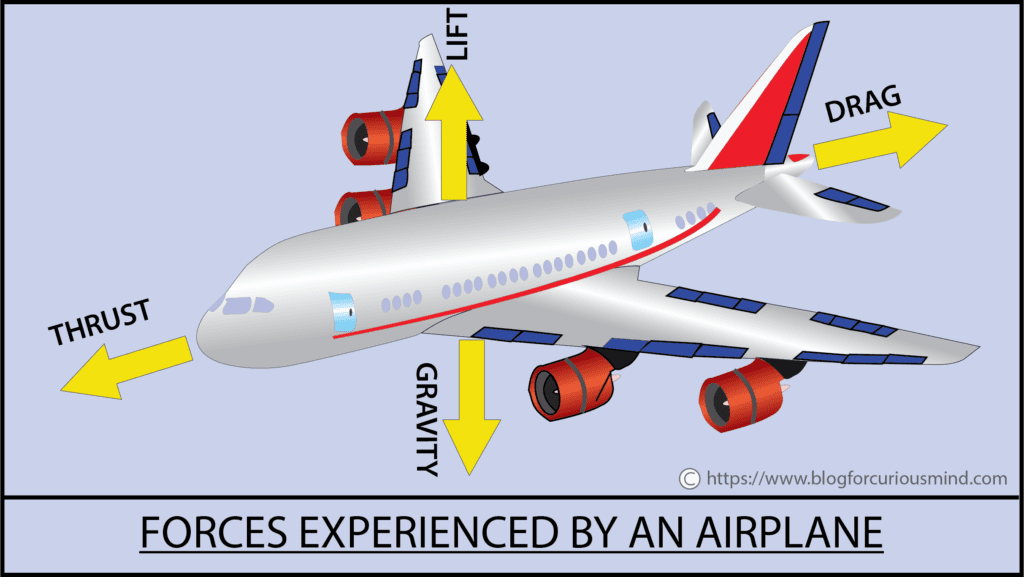
Newton’s third law of motion states ‘for every action or force in nature there is an equal and opposite reaction or another force‘. So, the thrust created by the jet engine to move the airplane forward is resisted by the air resistance that drags it. The thrust created should be high enough to overcome the drag to move it forward.
How an airplane fly
The airplane lifts into the air when the lift force created by it is sufficiently higher than the gravity. The pilot maneuvers the different controls to achieve the required lift.
When the airplane climbs to its altitude, it reaches its flight level. At this point, the forces of ‘thrust and drag‘ and ‘lift and gravity‘ get balanced and the airplane continues on a leveled flight.
Major parts of an airplane and their functions
Airplanes are designed for the transportation of people or cargo from one airport to another. They come in different sizes, shapes, and designs.
The pilot of an airplane has different controls for maneuvering it on land, and in the air. The Aileron, Elevator, and Rudder are the three primary control surfaces mandatory in all airplanes.
The major parts of an airplane are:
- Wings
- The tail
- Fuselage
- Engine
- Landing gear
Let us discuss these in detail.
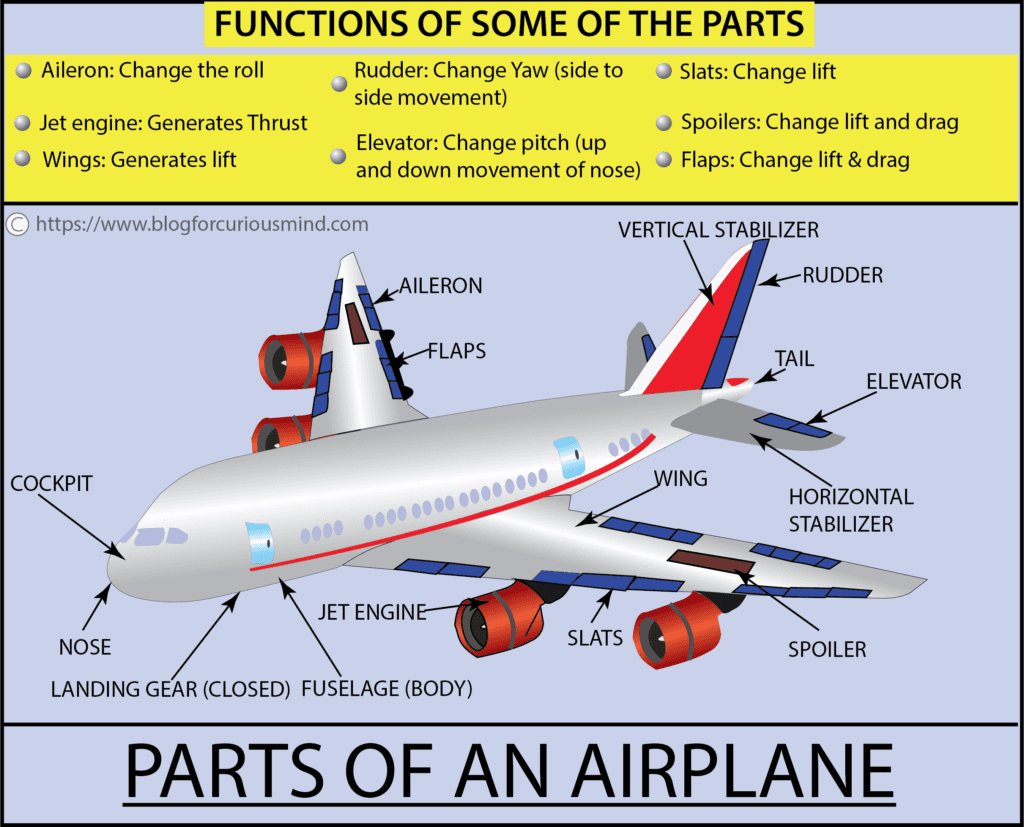
Wings
While flying in an airplane, you must have observed how large its wings are and how they are constructed. The work of the wings is to provide the lift force to lift the airplane into the air and make it fly.
Yes, you are correct!! The wings of an airplane are not made from a single solid piece. On the contrary, the wings have many movable parts. The complete wing along with its movable parts forms a special shape. In fluid mechanics, this special shape is called the airfoil.
The airfoil produces the lift for the airplane by using the air moving around it. The airfoil can be altered using the movable parts slat and flap to vary the lift force.
The wings generate most of the lift for the airplane to hold it in the air. It moves through the air to generate the lift. The air surrounding the airplane resists its forward movement. This resistance force is called aerodynamic drag. Some airplanes have winglets on wings to minimize aerodynamic drag. The jet engines generate the thrust to overcome the drag.
The moving parts on the wings are:
- Ailerons
- Flaps, slats, and spoilers
The moving parts on the wings are discussed below and the pilot controls all these moving parts from the cockpit.
Ailerons
Ailerons are the hinged parts at the trailing end of the wing (rear side). There is one on each wing. Ailerons help the pilot control the roll of the airplane and the pilot uses it for its side-to-side roll.
When the pilot turns to the left, the left aileron moves up (lift is reduced on the left wing) and the right aileron moves down (lift is increased on the right wing). The result is the airplane rolls to the left and begins a turn.
When the pilot turns to the right, the right aileron moves up (lift is reduced on the right wing) and the left aileron moves down (lift is increased on the left wing). The result is the airplane rolls to the right and begins a turn.
Flaps, slats, and spoilers:
Flaps, slats, and spoilers are called the secondary control surfaces of an airplane. Their function is to improve its performance characteristics and aid in flying it. Unlike the primary control surfaces, the secondary control surfaces are not mandatory for all airplanes.
Flaps
Flaps are hinged parts and like ailerons, are located on the rear side of the wing. However, unlike ailerons, flaps move symmetrically and this movement produces additional lift and drag.
Flaps are normally used during takeoff and landing when the airplane speed is low. Flaps help generate additional lift. They can only move downwards from their normal position and be deployed in angular increments.
Slats
Slats are hinged parts positioned on the front of the wings. When deployed, slats temporarily change the shape of the wings and enhance the lift during takeoff.
Slats enhance lift during low-speed maneuvers like takeoff, and initial climb. And also during approach and landing. Slats can only move downwards from their normal position and can be deployed in angular increments.
Spoilers
Airplanes are designed to minimize drag and increase fuel efficiency. An offshoot of this is that it does not slow down immediately even at idle thrust. This is more so during descending.
Spoilers are movable panels mounted on the top surface of the wing. When deployed, it will increase the drag and decrease the lift by distracting the airflow above the wings.
Spoilers are deployed during the airplane’s descent. Their function is to reduce the lift and allow it to lose altitude (descend) without an increase in airspeed. Spoilers are also deployed during landing to reduce airplane speed and they work against the flaps when the airplane is on the ground. Spoilers can be deployed only upwards.
When flying next time, take a window seat and watch how the different movable parts on the wings are manipulated during takeoff, leveled flight, turning, and landing.
The tail
The tail of an airplane offers stability and helps enhance the lift in combination with the wings.
You can see the vertical and horizontal stabilizers at the tail. They are like small wings fixed at the tail of the airplane. The fixed horizontal part at the tail is called the horizontal stabilizer and the fixed vertical part at the tail is called the vertical stabilizer.
The vertical and horizontal stabilizer helps control and maneuver the airplane, provide steadiness, and keep it on a level flight. The horizontal stabilizer avoids pitching of the nose (up and down movement) and the vertical stabilizer prevents the nose of the airplane from yawing (side-to-side movement).
The horizontal stabilizer and elevator
The horizontal stabilizer controls the nose from moving up and down (pitching). An elevator is the hinged part on the horizontal stabilizer and is one of the three primary flight controls (the other two are the aileron and rudder).
The pilot can move the elevators up or down. When the elevators are moved up, the tail is pushed down, and the nose of the airplane is tilted upwards. In the nose-up position, the angle of attack on the wings changes and more lift is created. This is used during takeoff. When the elevators are moved down, the tail is pushed up, and the nose of the airplane tilts downwards. This is used during descending.
Vertical stabilizer and rudder
The vertical stabilizer controls the yaw or sidewise movement of the airplane. The rudder, another primary control, is hinged to the vertical stabilizer and the pilot can move it to the left or right.
The pilot pushes the left pedal to turn the rudder to the left. This pushes the tail to the right and the nose yaws to the left. Similarly, when the pilot pushes the right pedal, the rudder turns right, and the nose yaws toward the right. The pilot uses ailerons in combination with the rudder for a smooth turn.
More about rudder and rudder pedals
There are two rudder pedals for the pilot to operate, left and right, and they control three things:
- Nose wheel (for turning when taxiing on the ground)
- Rudder
- Brake (operated only when the airplane is on the ground).
The rudder pedals have two parts, the bottom part controls the rudder (and the nose wheel when on the ground) and the top part controls the brake (when on the ground). Each side of the pedal controls the respective side of the control viz. the top left pedal activates the left brakes and the top right pedal activates the right brakes.
Fuselage
The fuselage is the body of the airplane and it holds the cockpit in the front and passenger and cargo space in the rear. Airplanes normally carry aviation fuel in the wings. However, some may use the space in the fuselage for aviation fuel.
The construction and design of the airplanes differ from manufacturer to manufacturer as also the purpose of the airplane. The aircrafts built for wars like fighter aircraft have a very different configuration when compared to a passenger or cargo airplane.
A fighter airplane has very different needs viz. quick functions, manipulations, reaching very high altitude, speed, and other things. Hence its configuration is completely different from a commercial airplane.
Whatever the design, the forces acting on an airplane remain the same and have to work with three axes while in the air.
Engine
The engine can be of propeller type or a turbine/jet engine. In a propeller-type engine, the fuel and the compressed air are burnt in an internal combustion engine to spin the propeller and the spinning propeller generates the thrust required for forward movement of the airplane.
In a jet or turbine engine, the air enters the engine, gets compressed, mixed with the aviation fuel, ignited, and the high-pressure exhaust moves out from the rear. All these processes are happening in line. In this, the thrust for the forward movement of the airplane is generated by the high-pressure exhaust.
Landing gear
The landing gear is positioned under the belly of the airplane and includes one set of wheels at the front and two sets of wheels at the rear. These wheels have the necessary arrangements to absorb the shock of landing and moving the airplane at high speed on the ground.
The pilot has the hydraulic controls to deploy the landing gear before landing and retract it into the fuselage after the airplane takes off. The landing gear is retracted into the fuselage to eliminate the additional drag it can create.
How do airplane wings lift the airplane?
Air is a fluid medium like water, with molecules and weight. Remember the experiment of weighing an empty balloon and a balloon filled with air!! However, the density of air is 1/800 that of water. Also, the air constantly moves around the objects open to it and can push or lift them. The objects the air can push or lift include an airplane.
Objects lighter than air are buoyant and can float. But heavier objects like an airplane need an upward force to keep afloat. This upward force is called the lift. The lift force for an aircraft is mostly developed by its wings. Let us discuss how an airplane gets lifted into the sky and keeps flying in the air.
The cross-section of an airplane wing has a curved shape at the top and is comparatively flat at the bottom. This shape makes the air move faster over the top of the wing and slower at the bottom.
As per the theory, the reason for the faster movement of air at the top is it has to cover more distance, compared to the air moving at the bottom. And the time for both movements is the same. As a result, the air pressure at the top of the wing is less than the air pressure at the bottom.
This difference in pressure increases with an increase in airplane speed. At a particular speed, the pressure difference is sufficient to lift the airplane into the air. This speed is called the take-pff speed.
The take-off speed for a light aircraft Cessna 150 can be around 62 MPH and jetliners use a takeoff speed of 149 to 177 MPH or more. This take-off speed is possible with the airplane’s nose pitched up at 5° to 15°. 5° to 15° nose up enhances the lift from the wings.
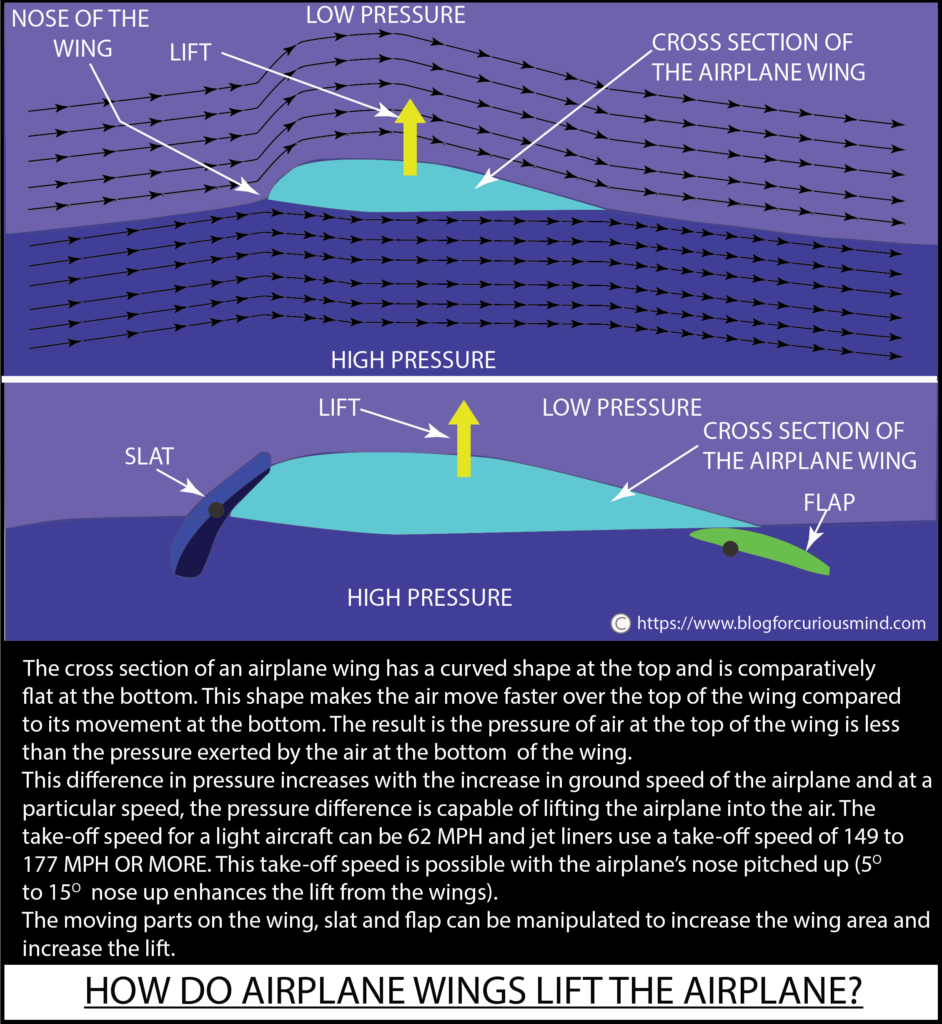
Many people do not accept this theory and offer the following explanation.
When the airplane is in the air, the cross-section of the wings affects the air moving around the wing. As the air meets the metallic surface of the wing, a thin layer of it sticks to the wing surface, and this thin layer drags the surrounding air with it. Now the air is divided into two pathways (above and below the wing) keeping with the wing contour.
The air above the wing moves around the nose of the wing and experiences a centripetal force or centripetal acceleration. This is the same force that throws you out of your seat when your bus makes a sharp and fast turn. Due to this incidence, the air above the wing moves at a higher velocity than the air below
The increase in velocity above the wing is always coupled with a decrease in pressure. On the other hand, the air moving below the wing does not experience a significant change in direction or speed.
So, the pressure below the wing is higher than it is above. This difference in pressure results in a positive upward force called the lift. With the increase in airplane ground speed, the lift also increases and when the lift force is more than the gravitational force the airplane takes off.
The three axes of an airplane’s flight
The three axes of an airplane’s flight are lateral, longitudinal, and vertical. The pitch implies the rotation around the lateral or side-to-side axis, the roll is the rotation around the longitudinal axis, and the yaw is the rotation around the vertical axis.
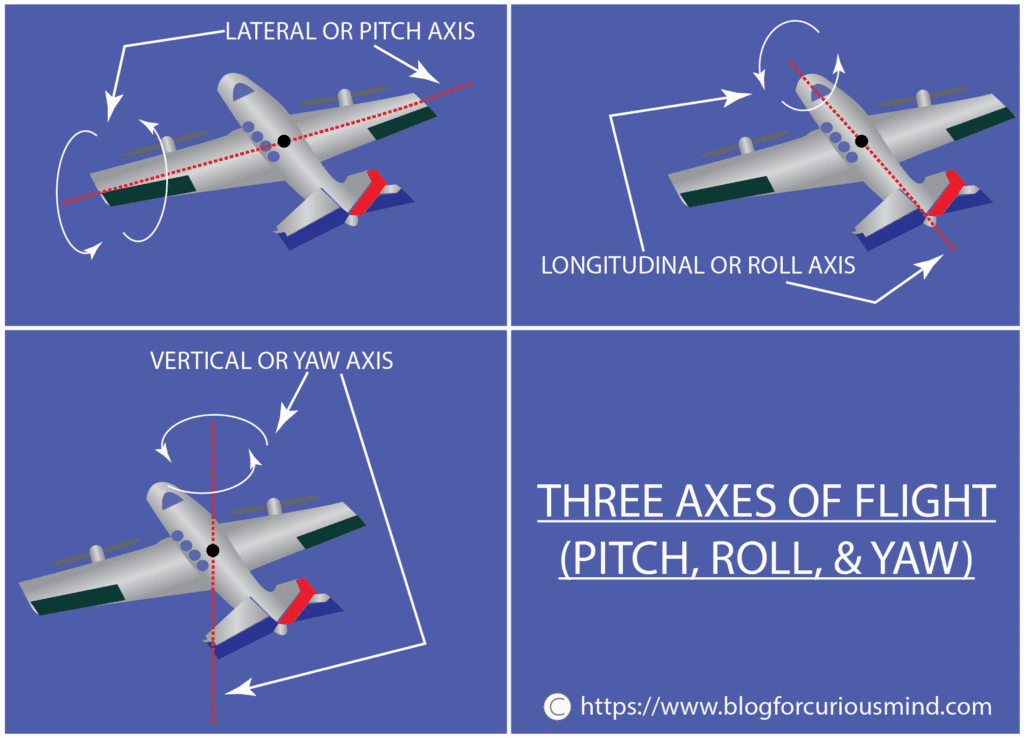
What are pitch, roll, and yaw?
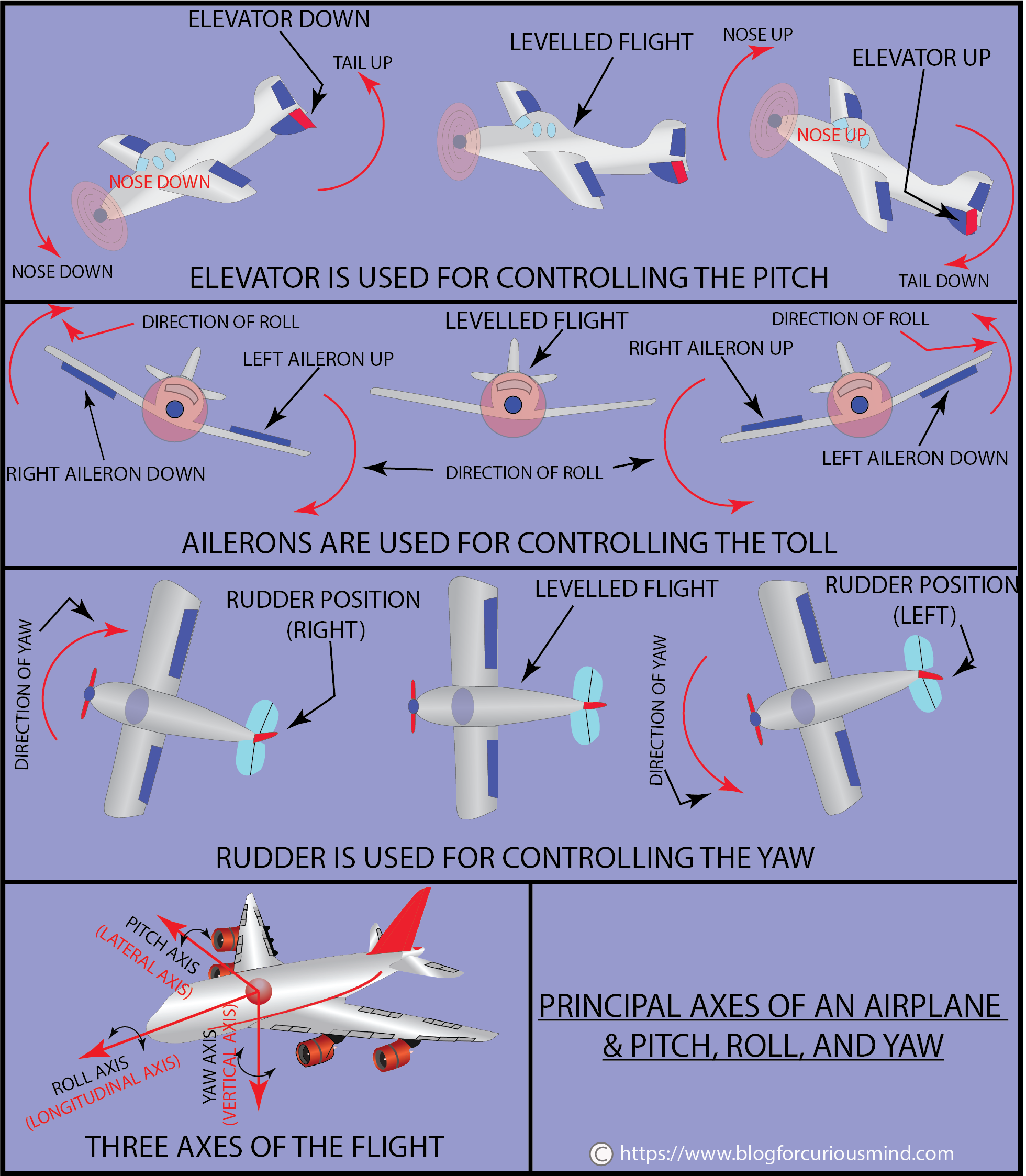
Pitch
Pitch is the rotation of an airplane around the lateral or side-to-side axis. You can imagine this motion as its nose-up and nose-down position. The axis of the pitch or the lateral axis rests above and along the airplane wings.
The pilot uses the elevator at the tail to pitch the airplane up or down (nose-up or nose-down). The elevator has two functions:
- It provides stability to the airplane by creating a downward force on the tail. Airplanes are normally built with a heavy nose and the downward force created by the elevator compensates for the heavy nose.
- Pitch the airplane nose upwards (nose-up) or downwards (nose-down). This is called pitch. The nose-up is used during climbing and the nose-down is used during descent.
When the elevators of the airplane are tilted upwards or skywards, it gets more lift on the wings and less on the tail, so the airplane pitches up (nose-up). When the elevators are tilted downwards or earthwards, the airplane gets less lift on the wings and more on the tail, so it pitches down (nose-down).
Roll
There are two ailerons at the back of the aircraft wing, one on each wing. These ailerons are operated for roll. The ailerons work opposite each other. Hence when one aileron is raised, the other is lowered.
The work of the aileron is to increase the lift on one wing and simultaneously reduce the lift on the other wing. This makes the airplane roll sideways, and the pilot uses this for its turning.
The pilot controls the roll of an airplane with its ailerons. Ailerons have a hinged construction and are located at the trailing edge of each wing.
The Yaw and roll of an airplane can be confusing so it is important to distinguish between them. Yaw refers to its ‘left and right‘ motion and roll implies its rocking motion (back and forth).
Yaw
The rudder is located on the tail of an airplane and has a hinged construction. Its function is similar to the rudder of a boat. However, an airplane uses both rudder and ailerons to make a smooth turn.
The major purpose of the rudder is to offset the drag produced by the lowered ailerons while making a turn.
Yaw is the rotation around the vertical axis and moves towards the left or right depending on the rudder position. The pilot controls the yaw with the rudder at the tail with hinges. Together with the ailerons, the rudder moves the tail to the left and the right and directs the airplane movement along the vertical axis.
The pilot does not use the rudder to turn the aircraft during a flight, but it is most efficiently used for controlling the roll axis while making the airplane turn.
What is the speed of an airplane?
The speed of commercial jet airplanes is in the range of 350 to 650 MPH. Supersonic planes fly above the speed of sound (767 MPH) and the speed can be in the range of 760 to 1350 MPH. However, there are no commercial supersonic airplanes at present.
What is the weight of an airplane?
The weight of the airplane built by the Wright brothers in 1903 was 274 kilograms. However, the average weight of the present-day commercial jet airplane ranges from 150 to 230 tons. And mind it, this is its empty weight. It becomes heavier when filled with fuel, people, and luggage.
The weight of an airplane filled with fuel, people, and luggage is called the maximum takeoff weight or MTOW. If an airplane is loaded beyond its MTOW, it may not be able to take off.
The maximum takeoff weight of an Airbus A380 is 575 tons and its takeoff speed is 315 KMPH or 196 MPH.
The weight of an airplane affects its fuel efficiency, and the environment since heavier airplanes consume more fuel and give out more emissions.
Conclusion
The airplane is fascinating and a delight. It is wonderful how a huge metal bird smoothly takes off and lands in an airport. Hope this article was able to answer some of your questions about it.
Caution
The purpose of this article is simply to satisfy the curiosity of a common person about the general construction of an airplane and how it flies in the air. This is not training material for a person to learn to fly an aircraft, small or big. Flying an airplane needs long hours of training, skill, and experience. If you are interested in learning how to fly an airplane, contact a training institute near you.
References
https://www1.grc.nasa.gov/beginners-guide-to-aeronautics/airplane-parts-function
https://www.flyaeroguard.com/learning-center/parts-of-an-airplane
https://www.grc.nasa.gov/www/k-12/UEET/StudentSite/dynamicsofflight.html
https://calaero.edu/aircraft-axes-pitch-yaw-roll
https://howthingsfly.si.edu/sites/default/files/2020-06/pitch-roll-yaw_0.gif

